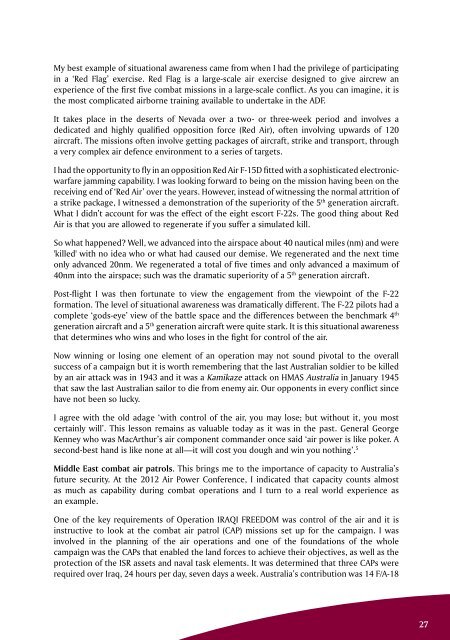190%202013%20Mar_Apr
190%202013%20Mar_Apr
190%202013%20Mar_Apr
Create successful ePaper yourself
Turn your PDF publications into a flip-book with our unique Google optimized e-Paper software.
My best example of situational awareness came from when I had the privilege of participating<br />
in a ‘Red Flag’ exercise. Red Flag is a large-scale air exercise designed to give aircrew an<br />
experience of the first five combat missions in a large-scale conflict. As you can imagine, it is<br />
the most complicated airborne training available to undertake in the ADF.<br />
It takes place in the deserts of Nevada over a two- or three-week period and involves a<br />
dedicated and highly qualified opposition force (Red Air), often involving upwards of 120<br />
aircraft. The missions often involve getting packages of aircraft, strike and transport, through<br />
a very complex air defence environment to a series of targets.<br />
I had the opportunity to fly in an opposition Red Air F-15D fitted with a sophisticated electronicwarfare<br />
jamming capability. I was looking forward to being on the mission having been on the<br />
receiving end of ‘Red Air’ over the years. However, instead of witnessing the normal attrition of<br />
a strike package, I witnessed a demonstration of the superiority of the 5 th generation aircraft.<br />
What I didn’t account for was the effect of the eight escort F-22s. The good thing about Red<br />
Air is that you are allowed to regenerate if you suffer a simulated kill.<br />
So what happened? Well, we advanced into the airspace about 40 nautical miles (nm) and were<br />
'killed' with no idea who or what had caused our demise. We regenerated and the next time<br />
only advanced 20nm. We regenerated a total of five times and only advanced a maximum of<br />
40nm into the airspace; such was the dramatic superiority of a 5 th generation aircraft.<br />
Post-flight I was then fortunate to view the engagement from the viewpoint of the F-22<br />
formation. The level of situational awareness was dramatically different. The F-22 pilots had a<br />
complete ‘gods-eye’ view of the battle space and the differences between the benchmark 4 th<br />
generation aircraft and a 5 th generation aircraft were quite stark. It is this situational awareness<br />
that determines who wins and who loses in the fight for control of the air.<br />
Now winning or losing one element of an operation may not sound pivotal to the overall<br />
success of a campaign but it is worth remembering that the last Australian soldier to be killed<br />
by an air attack was in 1943 and it was a Kamikaze attack on HMAS Australia in January 1945<br />
that saw the last Australian sailor to die from enemy air. Our opponents in every conflict since<br />
have not been so lucky.<br />
I agree with the old adage ‘with control of the air, you may lose; but without it, you most<br />
certainly will’. This lesson remains as valuable today as it was in the past. General George<br />
Kenney who was MacArthur’s air component commander once said ‘air power is like poker. A<br />
second-best hand is like none at all—it will cost you dough and win you nothing’. 5<br />
Middle East combat air patrols. This brings me to the importance of capacity to Australia’s<br />
future security. At the 2012 Air Power Conference, I indicated that capacity counts almost<br />
as much as capability during combat operations and I turn to a real world experience as<br />
an example.<br />
One of the key requirements of Operation IRAQI FREEDOM was control of the air and it is<br />
instructive to look at the combat air patrol (CAP) missions set up for the campaign. I was<br />
involved in the planning of the air operations and one of the foundations of the whole<br />
campaign was the CAPs that enabled the land forces to achieve their objectives, as well as the<br />
protection of the ISR assets and naval task elements. It was determined that three CAPs were<br />
required over Iraq, 24 hours per day, seven days a week. Australia’s contribution was 14 F/A-18<br />
27


